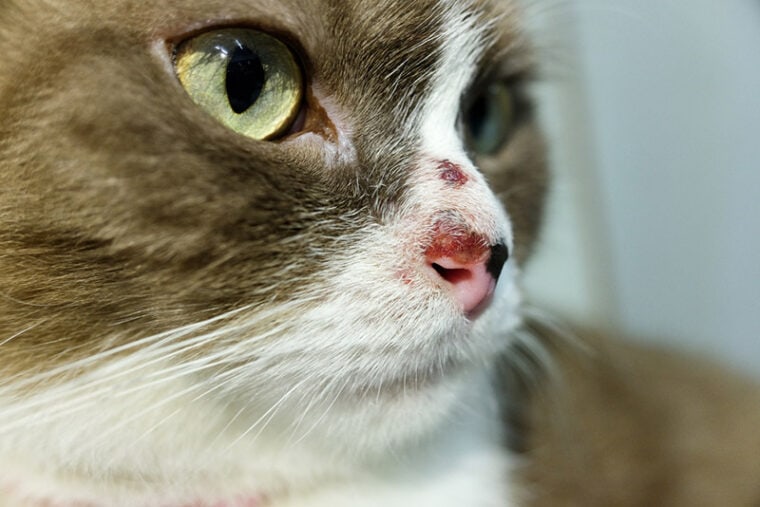
If you see a scab on your cat, you may wonder what happened, why it’s there, and if you should pick it off or not. The short answer is, no, don’t pick off the scab! In this article, we’ll learn a little about what scabs are, the potential causes of them in a cat, as well as what we should do if we see a scab present. Read on to learn more!
What Are Scabs?
Scabs are the body’s natural band-aid, placing a plug over the wound to allow for it to heal from the inside out. As soon as there is a break in the skin, platelets and clotting factors will be brought to the site to stop the blood loss. As these cells dry, they then form the scab. Underneath this scab, additional cells are then brought in to decrease inflammation and promote healing. Ideally, as the wound heals, the scab will eventually fall off and allow the healed tissue underneath to be exposed.
Of course, scabs do not appear by themselves but are rather the secondary result of a primary cause. Any cat owner that sees a scab on their cat should prioritize investigating the primary cause. A scab could be caused by a variety of sources, some of which will be pointed out next.

Potential Causes of Scabs in Cats
A cat could get a scab (or scabs), for a number of reasons. These could range from getting a scratch from another animal to a parasite bite, or self-mutilation from scratching due to allergies. While the causes can be diverse, some possibilities are listed below.
Often, in the case of cat scabs, miliary dermatitis may be present on the skin as evidence that there is a larger issue going on with the cat’s overall health. Miliary dermatitis is when a cat has many small pimple-like bumps on the skin that have a crust or scab present. This is not a disease in and of itself but may be a sign or response to some other primary medical condition. These primary causes could include those listed above, such as a flea allergy or skin mites. Further investigation will need to be determined to find out the cause of miliary dermatitis and the source of these scabs.

Should I Pick Scabs Off My Cat?
As mentioned earlier, scabs are the body’s natural process of healing a wound. To allow for the best chance of letting the injury heal quickly and properly, the best course of action is to let the scab fall off on its own.
While humans are often very concerned that removing a scab too early will worsen scar formation, in cats the primary concern and reason for leaving the scab alone is to ensure optimal health and recovery. To decrease the risk of infection, we should make sure the scab is bothered as little as possible and prevent the wound from reopening. While this means one shouldn’t pick at the scab, it also means that we should try to prevent the cat in question from self-mutilating (licking, biting, scratching) the area to allow it the best chance at having an uncomplicated healing process.
What Should I Do If My Cat Gets Scabs?
At home
If there’s a simple minor scab or two, you may not need to rush to the veterinarian but do closely monitor it. If the scabs are increasing in number or severity, are not healing over time, are accompanied by prominent itchiness or hair loss, or have signs of infection (such as redness, swelling, and/or pain), it would be a good idea to make an appointment with your cat’s veterinarian.

At the veterinary office
In the event that a cat’s scabs are part of a larger medical concern, the veterinarian will want to see the scabs in their severity and location without having them removed. They may even need to take a sample of the scabbed area, so again, it’s best to leave the area alone prior to having them seen.
The veterinarian will need a detailed history and will conduct a complete physical exam. Depending on what they glean from these things, they may need to conduct additional tests to help locate the primary cause of the scabs. Some potential tests could include skin scrapes, fungal cultures, checking for external parasites, food allergy testing, intradermal skin testing, or getting a sample of the skin to be evaluated under the microscope. These tests may be done in various phases to rule in or out different causes. In some circumstances, a referral to a veterinary dermatologist may be indicated. The prescribed treatment will be determined by the inciting cause of the scabs.
It’s important to note that as scabs harden and heal, they can then become dry. Dryness may cause your cat discomfort, itching, or self-mutilation. To help your cat with the healing process, you can discuss with your veterinarian some options that may help your cat such as an Elizabethan collar (to keep them from licking or chewing at their skin), ointment (to medicate, help calm, and hydrate the affected areas) that is appropriate to use on cats, or other options that may help with hair/skin health such as vital nutrients or supplements (e.g. vitamin E).
Conclusion
A minor scab on a cat should be left to heal and not be removed or picked off. If there are numerous or recurring scabs, or there are other signs of a problem (such as having the area infected or intense itchiness), making a veterinary visit to have your cat examined would be a good next step. As there are many potential causes of scabs on a cat, this visit can help to determine the primary cause, resolve the underlying health problem, and take care of the scabs all at once.
Featured Image Credit: Darika Sutchiewcharn, Shutterstock








